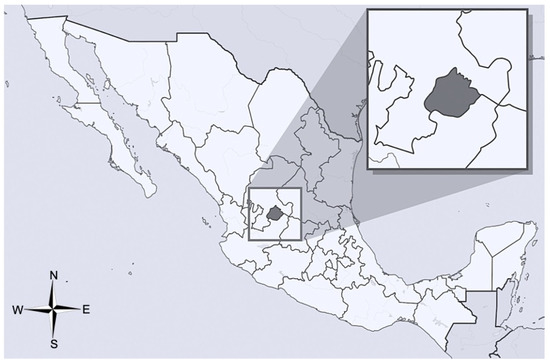Abstract
This paper estimates the prevalence and severity of dental fluorosis among participants in the first wave of The Aguascalientes Longitudinal Study of Child Development (EDNA). The analytical sample includes 1052 children in 100 public elementary schools. Dental fluorosis is determined using the Modified Dean’s Index. There is a 43% general dental fluorosis prevalence, and the estimated Community Fluorosis Index is 0.99. Five municipalities report average groundwater fluoride concentrations above the official Mexican guideline value of 1.5 mg/L. In those municipalities, there is a 50% average dental fluorosis prevalence. An ordered logistic regression analysis indicates that obesity in participants increases the likelihood of suffering more severe dental fluorosis symptoms compared with normal-weight participants (OR = 1.62, p < 0.05). Households consuming tap water are more likely to have children suffering more severe dental fluorosis symptoms (OR = 1.63, p < 0.05). Children aged 8 years are more likely to present more severe dental fluorosis symptoms than their peers aged 7 years (OR = 1.37, p < 0.05). Dental fluorosis will persist as a public health problem in Aguascalientes State unless appropriate technologies for fluoride removal from water are installed and operated.
*Original abstract online at https://www.mdpi.com/2073-4441/13/8/1125/htm
Excerpt:
1. Introduction
Dental fluorosis and skeletal fluorosis are major public health concerns around the world. Regions with a high prevalence of such illnesses have been recently documented in Asia, particularly in China [1,2,3,4], India [5,6,7,8], Pakistan [9,10,11], and Sri Lanka [12,13,14]. In Africa, dental fluorosis is prevalent mainly in Sub-Saharan countries, including Kenya, Tanzania, Uganda, Ethiopia, Eritrea, Sudan, Ghana, Malawi, Niger, Nigeria, Mozambique, and South Africa [15,16,17]. In Latin America, dental fluorosis has been documented in Brazil [18,19,20,21], Argentina [22,23], and Mexico [24,25,26,27]. It is well-established in the public health literature that fluoride, commonly used in dental preparations (e.g., toothpaste, gels, and varnishes) or added to certain vehicles such as water, milk, and salt, is effective in preventing dental caries and the minimum fluoride concentration for obtaining such protection is 0.5 mg/L [28,29,30]. Communities where naturally occurring fluoride in water is very low may benefit from exposure to slightly higher fluoride concentrations to reduce caries prevalence [31,32], and might reduce bone fracture risk [33,34]. The U.S. Public Health Service suggests an optimal fluoride concentration in water of 0.7 mg/L, since this level has a protective effect against dental caries and reduces the risk of dental fluorosis [35]. Nevertheless, chronic exposure to high fluoride levels through water, food, and fluoridated dental preparations increases the likelihood of suffering dental and skeletal fluorosis [5,28,36,37]. The first edition of the Guidelines for Drinking-Water Quality published by the World Health Organization (WHO) in 1984 [38] recognized that dental fluorosis is associated with fluoride levels in drinking water above 1.5 mg/L. However, the WHO Guidelines for Drinking-Water Quality fourth edition states that fluoride drinking water concentrations between 0.9 and 1.2 mg/L may provoke mild dental fluorosis depending on fluoride exposure to other sources (with a 12% to 33% prevalence). Further, skeletal fluorosis may occur in regions where drinking-water fluoride concentrations range between 3 and 6 mg/L, and crippling skeletal fluorosis may develop if fluoride levels in drinking water exceed 10 mg/L [28].
In Mexico, some states report high fluoride concentrations in groundwater, and dental fluorosis is prevalent in such areas [24,39,40]. Aguascalientes is a state located in North-Central Mexico (see Figure 1) with an average altitude of 1951 m above sea level. Several studies have reported fluoride concentrations in groundwater above the limit of 1.5 mg/L, established in the official Mexican guideline (NOM-127-SSA1-1994 [41]) in some aquifers in the state (see [40,42,43,44,45]). In the early 2000s, dental fluorosis was identified as a critical public health problem in the state [42,43,45]. Using the 2001 National Dental Caries Survey, Betancourt-Lineares et al. [45] found an 83.8% dental fluorosis prevalence in Aguascalientes in a sample of 903 children aged 12 and 15 years old and estimated a 1.02 Community Fluorosis Index. Hernández-Montoya et al. [43] reported in 2003 a dental fluorosis prevalence higher than 50% in children living in zones where fluoride levels in drinking water were below the guideline value of 1.5 mg/L. Almost twenty years after those research papers were published, it is essential to assess the current dental fluorosis situation in the latest generation of children. This study aimed to assess the current prevalence and severity of dental fluorosis among elementary school children and determine if dental fluorosis is still a public health problem. This study also analyzed the association between socioeconomic variables, other risk factors, and dental fluorosis. The analysis data were obtained from the participants in The Aguascalientes Longitudinal Study of Child Development (EDNA). These data are unique because access to schoolchildren and their families is difficult. Additionally, the sample size allowed for conducting state-level analysis.

Figure 1. Aguascalientes location.
*Original abstract online at https://www.mdpi.com/2073-4441/13/8/1125/htm
